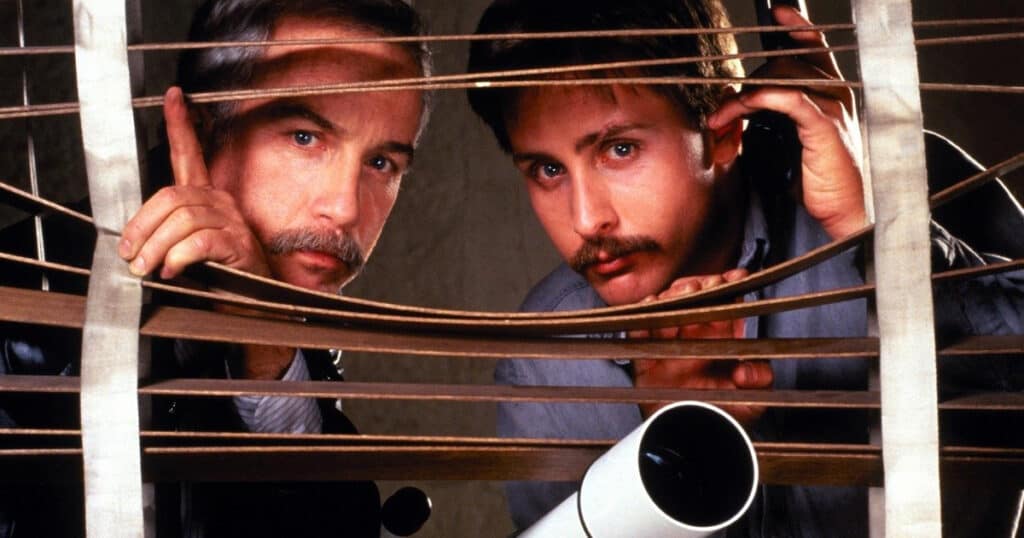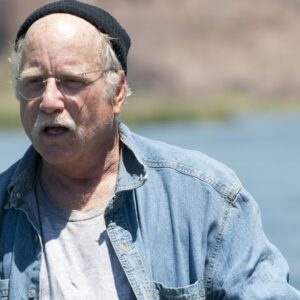Last Updated on October 14, 2024
Picture this: A big-name actor strolls on stage to intro a screening of one of his classic flicks. So far, so good. But hold up – he’s rocking a dress? Wild. The crowd’s eating it up, but then some stagehands rush in to yank it off him. He doesn’t put up much of a fight, but the audience is not having it – they’re booing like crazy. It turns out that the dress was part of the gag all along, but maybe not the awkward strip show. Little did they know, this wacky moment was just a warm-up for what was coming: Richard Dreyfuss going off about kids changing genders, the parents that push them into it, women in Hollywood (including a dig at his old co-star Barbra Streisand), and the whole #MeToo thing. Talk about a plot twist.
Was this just another celeb crash-and-burn, Hollywood chewing up and spitting out another star? Or is this the same old Richard Dreyfuss we’ve always known? Maybe this is the guy who’s always spoken his mind, consequences be damned – the same stubbornness that made him a big-time actor in the first place? Maybe we don’t need to play that whole ‘separate the art from the artist’ game here. It looks like what you see is what you get with Dreyfuss – on screen or off.
Lately, it seems like he’s been mostly off-screen. But has he really? What’s he been up to besides shopping for dresses? And how did he get to this point? It turns out that speaking his mind runs in the family. His mom was an activist, and his dad was a lawyer. No wonder Dreyfuss thinks it’s his job to stir the pot.
Early roles
Dreyfuss got his acting start in community theater at age 9 and was already on tv by age 15, featuring in a television production of the play In Mama’s House. Dreyfuss bounced around roles in Hollywood and on Broadway, notably delivering literally one line in The Graduate in 1967, before really getting everyone’s attention as Baby Face Nelson in Dillinger in 1973. It was written and directed by John Milius, who worked with Francis Ford Coppola and pre-Star Wars George Lucas.
Speaking of George Lucas, another one of Dreyfuss’ early roles was in Lucas’ classic 1973 coming-of-age film American Graffiti, which became one of the biggest hits of the year and put him on the map in a big way. 1974 saw him in The Apprenticeship of Duddy Kravitz, where he got to show off some of his own stubborn determination.

Jaws and stardom!
His lifelong partnership with Steven Spielberg started, of course, with 1975’s Jaws. However, calling it a partnership doesn’t quite capture it. There’s no Richard Dreyfuss without Steven Spielberg, and there’s no Steven Spielberg without Richard Dreyfuss. Dreyfuss has been called Spielberg’s muse and is definitely the guy Spielberg used when he wanted to put himself into his movies. Dreyfuss and Spielberg were both crowned Hollywood’s golden boys before they really hit it big.
And boy did they hit it big. Jaws remains Dreyfuss’ highest-grossing film, even without adjusting for inflation. Jaws didn’t just make waves; it created a tsunami in Hollywood and beyond. This fish tale chomped through box office records, spawned a feeding frenzy of summer blockbusters, and took a massive bite out of beach tourism. It basically rewrote the rules for movies, moneymaking, and how we look at the ocean. Jaws didn’t just change the game – it flipped the whole board, tossed the pieces in the air, and had everyone scrambling to catch up.
Dreyfuss was also in Inserts in 1975, which I’ll just kinda insert here before talking about his next collab with Spielberg. Dreyfuss told “Inside the Actors Studio” in 2020 that when his acting career first began in the 1960s, he was afraid of being pigeonholed into Sci-Fi roles. It’s ironic, then, that he would lead one of the movies most responsible for legitimizing the genre, 1977’s Close Encounters of the Third Kind. He was reportedly the sixth choice for the role after Steve McQueen, Gene Hackman, Dustin Hoffman, Jack Nicholson, and Al Pacino all turned it down. Still, now I can’t see anyone else portraying an everyman’s descent into madness any better. Dreyfuss eventually wore Spielberg down by talking with him endlessly about the project while on the set of Jaws and even contributing ideas. He also not-so-subtly talked down the actors chosen ahead of him, shouting stuff like “Al Pacino has no sense of humor” or “Jack Nicholson is too crazy” while walking by Spielberg’s office.
Dreyfuss won the Oscar for Best Actor in a Leading Role for the 1977 filmThe Goodbye Girl. At age 30, he was the youngest to win the award until Adrien Brody won it for The Pianist at age 29 in 2003.
But, there was a dark side to all the fame. Richard Dreyfuss has no memory of filming 1981’s Whose Life is it Anyway?, due to his drug issues at the time, which is a shame, because it’s actually a pretty smart movie about a person’s right to die. And then he almost actually died from a 1982 car accident. He didn’t injure anyone else in the accident, but while he was in the hospital, he had a vision of a young girl in a white dress, who he took to represent the innocent lives he placed at risk with his reckless behavior. This wake-up call was the push he needed to get his act together. Get it? Act?

Eighties comeback
He was no longer Down and Out in Beverly Hills, which is also the name of the 1986 film that was the first real look at his comedic chops. And I think we all remember him bookending Stand By Me in that same year. This could have been just a good movie, but with Dreyfuss, it’s great. He was busy in 1987, starring alongside Danny DeVito in a buddy comedy, which I think is just something you were required to do if you were an actor in the late 80s. This one is called Tin Men, and it’s…it’s fine. Dreyfuss’ 1987 also included Nuts. I know that sounds like it’s another buddy comedy, but it’s actually a super serious legal drama. He was also in 1987’s Stakeout opposite Emilio Estevez, which people liked enough to justify a sequel, Another Stakeout, in 1993.
Dreyfuss sang and danced in Moon Over Parador in 1988 and was a friendly ghost when he was back with Spielberg for 1989’s Always. He then did Let it Ride in 1989 and played a supporting role as a psychiatrist in Postcards from the Edge in 1990, which was written by Carrie Fisher and loosely based on her own life. He got to fulfill his love for Shakespeare in 1990’s Rosencrantz & Guildenstern Are Dead, his only silver screen Shakespeare appearance if you don’t count The Goodbye Girl.
At this point, you may be wondering What About Bob?, and yes, Dreyfuss played another psychiatrist opposite Bill Murray in 1991 and showed he could hold his own with the comedy heavyweight. His character worked to clear the name of real-life historical figure Alfred Dreyfus in the made-for-tv movie Prisoner of Honor. The actor grew up thinking he was related to the French officer. 1991’s Once Around is kinda like if Guess Who’s Coming to Dinner was about white people being racist toward other white people.
Richard Dreyfuss sported a pretty cool mustache in 1993’s Lost in Yonkers before playing ANOTHER psychiatrist in 1994’s Silent Fall. In 1995, he played a Senator in Rob Reiner’s The American President, before being nominated for an Oscar for his passionate, soulful performance in 1996’s Mr. Holland’s Opus. He got to lean into his Brooklyn accent as Mr. Centipede in James and the Giant Peach and go across the bridge for Night Falls on Manhattan. 1996 is also when he got his star on the Hollywood Walk of Fame. The next year, he was ranked #81 in Empire magazine’s list of the top 100 movie stars of all time.
1998 saw Dreyfuss in Krippendorf’s Tribe, which was pretty terrible, but even just looking at the poster, you can’t question his dedication. He appeared with Eric Roberts in the 1999 tv mobster movie Lanksy and then in the theatrical mobster movie The Crew in 2000, which is more famous for the scene where Jeremy Piven sucks on Carrie-Anne’s toes. Quentin Tarantino, eat your heart out.
In 2001, Dreyfuss played in The Old Man Who Read Love Stories and fought a jaguar in a role originally envisioned for Morgan Freeman. Returning to television and into the political realm earned him a Satellite award and a SAG nomination for his role in The Day Reagan was Shot as the Secretary of State striving to keep everyone calm in the chaos. Still political but more satirical was 2004’s Silver City, where Dreyfuss plays an over-the-top campaign manager.

Career slump
2006’s Poseidon features Richard Dreyfuss, but somehow no sharks. Viewers of the 2007 Jaws documentary The Shark is Still Working may have been surprised to find that Richard Dreyfuss was still working at this point. From Senator to Secretary of State to Vice President Dick Cheney in Oliver Stone’s W in 2008. Dreyfuss would go on to call Stone “a fascist” on The View, and Stone said working with Dreyfuss “was the single worst experience [he’d] ever had with an actor in [his] life.” For what it’s worth, this is a pretty common pattern with Oliver Stone, and most complaints about Richard Dreyfuss are from the past year.
In 2009, Dreyfuss worked under the direction of Tim Blake Nelson in the stoner-adjacent Leaves of Grass and in the romance flicks The Lightkeepers and My Life in Ruins. He pops up in the trashy (but super fun) 2010 flick Piranha 3D for a blatant Jaws homage. 2010’s RED may be the last big, good movie he’s been in, though it’s not like he was in it much.
I’m gonna quickly go through some of what he’s done since 2010, and if you’ve heard of any of these, congrats, because I hadn’t. 2013 saw him in Paranoia, which I guess actually has some big names in it, but no one saw it. In 2015, Dreyfuss was in a not-bad Sundance movie called Zipper, which never made it to theaters. In 2016, he played the title character in the ABC miniseries Madoff, which beat HBO’s 2017 The Wizard of Lies to the punch.
Speaking of HBO, Dreyfuss featured in their 2017 puff piece Spielberg before returning to romcoms with 2018’s Book Club. He reprised the role in 2023’s Book Club: The Next Chapter, which a lot less people saw than the first chapter. He featured in Cuba Gooding Jr.’s directorial debut Bayou Caviar in 2018 and in the 2019 Netflix feature The Last Laugh in 2019, along with Chevy Chase and some actually funny people. Also in 2019, he starred in Daughter of the Wolf with Gina Carano, who’s also no stranger to speaking her mind.
Coming up, Dreyfuss has Waltzing with Brando, where Billy Zane plays Marlon Brando (why didn’t that happen sooner?) So where does that leave Richard Dreyfuss, now? In a dress on a Massachusetts stage, on every screen imaginable, and in cinema history. His antics may get him some heat, but he’s not getting out of the kitchen. He’s going to keep acting, advocating for civics education in classrooms, loving Civil War reenactments and hating Rock n’ Roll. He’s stubborn like that. He can’t stop. He won’t stop. “if I don’t do this, *that’s* when I’m going to need a doctor.”




















Follow the JOBLO MOVIE NETWORK
Follow us on YOUTUBE
Follow ARROW IN THE HEAD
Follow AITH on YOUTUBE